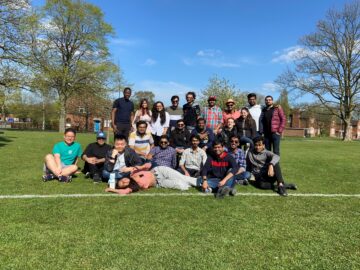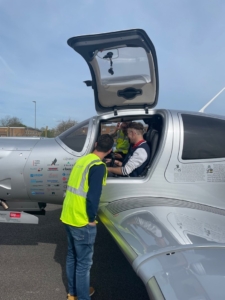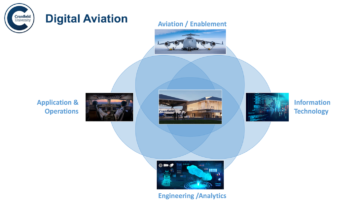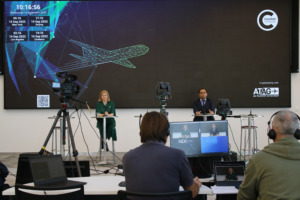
Our lives run on the supply of an invisible utility: accurate time. Starting with the morning alarm on our smartphone, it’s the basis of the everyday information we rely on for travel schedules, journey updates and location information, where a lack of synchronisation leads to disruption and a steady accumulation of problems. And it’s there in the background, an integral element in the running of the UK’s national infrastructure: communications, energy, banking and emergency services. That time information has to come from somewhere — and it has to be right.
Guaranteed time information is crucial
The government’s Blackett review, Satellite-derived Time and Position: A Study of Critical Dependencies (2018), set out the problems now being faced. The UK, like much of the world, relies on open services for time information: a network of satellites known as the global navigation satellite systems (GNSS). These services are known to be vulnerable in many ways. There are regular GNSS failures because of signals being jammed (intentionally and unintentionally) and spoofed; when there are satellite and receiver system errors, cybersecurity issues, and when there’s the wrong kind of solar weather. Mountains, buildings and trees have been found to degrade or affect the quality of GNSS signals.
The standard engineering solution for obtaining time information, embedded everywhere, GNSS is estimated to directly support 13.4% of the UK economy. Outages in terms of time information contribute to a cost of more than £1 billion a day. Creating a resilient system independent of GNSS for sharing reliable time information is critical for now — and even more so for the future. None of the expected and planned innovations around 5G and 6G, such as smart cities and autonomous transport, the Internet of Things and virtual healthcare, can happen without guarantees of time information.
The UK is ahead of the rest of Europe in its emphasis on time information: including the creation of the national Position, Navigation and Timing (PNT) Office and a ten-point resilient PNT framework to drive PNT policy, coordination, and delivery.
Building resilience and future capabilities
Cranfield is contributing to the research and development of a new, nationally distributed time infrastructure, that will provide the UK with its own sovereign capability to disseminate time data — establishing a basis of independence, resilience and trust (through traceability of information). We are one of three UK institutions hosting national Research and Innovation Timing Nodes (alongside Strathclyde and Surrey universities) with an atomic clock synchronised to the UK national time scale presented by the National Physical Laboratory (NPL), Coordinated Universal Time (UTC).
We’re working on the research project led by iQuila, with Quantum Dice as part of the National Timing Centre programme. Cranfield’s particular role has been in developing and refining the process for sending time information from the Timing Node wirelessly, and to end users who are either static or on the move. This involves making sure the information from the Node can be merged with other sources of time on-board, whatever the user platform might be (on the ground, or in the air); and critically, ensuring the time information available to the user is traceable, so the source of the information is known and guaranteed.
On 18 March 2024 we completed a demonstration of a software-defined network for disseminating time in a scalable and assured way, underpinned by a quantum security mechanism. The use of a software-defined network makes the proposed time dissemination solution faster and more flexible in terms of the physical connectivity and network functionality. In this way, there is a basis for the biggest, complex multiple systems operations, on the ground or aerial, such as dealing with fleets of autonomous vehicles in the air and on the ground. The demonstration confirmed that the proposed time infrastructure delivers the necessary standards of performance and resilience of the system in the absence of any supporting GNSS information.
Now we’re working on enhancements of the system, carrying out research into how levels of accuracy can be improved still further through other dissemination channels. The demonstrator system at the University has already attracted interest from the end users of the technology, OEM and regulatory authorities.
- SEO Powered Content & PR Distribution. Get Amplified Today.
- PlatoData.Network Vertical Generative Ai. Empower Yourself. Access Here.
- PlatoAiStream. Web3 Intelligence. Knowledge Amplified. Access Here.
- PlatoESG. Carbon, CleanTech, Energy, Environment, Solar, Waste Management. Access Here.
- PlatoHealth. Biotech and Clinical Trials Intelligence. Access Here.
- Source: https://blogs.cranfield.ac.uk/aerospace/how-were-helping-the-uk-take-back-control-of-time/
- :has
- :is
- :where
- 13
- 2018
- 2024
- 5G
- 6G
- a
- absence
- AC
- accumulation
- accuracy
- accurate
- affect
- ahead
- AIR
- alarm
- alongside
- already
- an
- and
- any
- ARE
- around
- AS
- assured
- At
- attracted
- Authorities
- autonomous
- autonomous vehicles
- available
- back
- background
- Banking
- basis
- BE
- because
- been
- being
- Biggest
- Billion
- blogs
- buildings
- by
- CAN
- capability
- carrying
- centre
- channels
- Cities
- Clock
- CO
- come
- Communications
- Completed
- complex
- CONFIRMED
- Connectivity
- contribute
- contributing
- control
- coordinated
- coordination
- Cost
- Creating
- creation
- critical
- Cybersecurity
- data
- day
- dealing
- delivers
- delivery
- demonstration
- developing
- Development
- directly
- Disruption
- distributed
- drive
- either
- element
- embedded
- emergency
- emphasis
- end
- energy
- Engineering
- enhancements
- ensuring
- Errors
- establishing
- estimated
- Europe
- Even
- everyday
- everywhere
- expected
- faced
- failures
- faster
- flexible
- For
- found
- from
- functionality
- further
- future
- Global
- Ground
- guaranteed
- guarantees
- happen
- Have
- healthcare
- helping
- hosting
- How
- HTTPS
- improved
- in
- Including
- independence
- independent
- information
- Infrastructure
- Innovation
- innovations
- institutions
- integral
- intentionally
- interest
- Internet
- internet of things
- into
- invisible
- involves
- issues
- IT
- ITS
- journey
- jpg
- Kind
- known
- laboratory
- Lack
- Leads
- Led
- levels
- like
- Lives
- location
- MAKES
- Making
- many
- March
- March 2024
- mechanism
- might
- more
- morning
- move
- much
- multiple
- National
- nationally
- Navigation
- necessary
- network
- New
- node
- None
- now
- obtaining
- of
- Office
- on
- ONE
- open
- Operations
- or
- Other
- our
- out
- Outages
- own
- parliament
- part
- particular
- performance
- physical
- planned
- platform
- plato
- Plato Data Intelligence
- PlatoData
- policy
- position
- presented
- problems
- process
- programme
- project
- proposed
- provide
- quality
- Quantum
- RE
- refining
- regular
- regulatory
- reliable
- relies
- rely
- research
- research and development
- resilience
- resilient
- REST
- review
- right
- Role
- Run
- running
- satellite
- satellites
- scalable
- Scale
- security
- sending
- Services
- set
- sharing
- signals
- smart
- Smart Cities
- smartphone
- So
- solar
- solution
- somewhere
- Source
- Sources
- sovereign
- standard
- standards
- Starting
- static
- steady
- Still
- Study
- such
- supply
- support
- Supporting
- sure
- Surrey
- system
- Systems
- Take
- Technology
- terms
- than
- that
- The
- The Future
- the information
- The Source
- the UK
- the world
- There.
- These
- things
- this
- three
- Through
- time
- timing
- to
- Traceability
- traceable
- transport
- travel
- Trees
- Trust
- Uk
- underpinned
- Universal
- Universities
- university
- Updates
- use
- User
- users
- UTC
- utility
- Vehicles
- Virtual
- Vulnerable
- Way..
- ways
- we
- we are one
- Weather
- whatever
- when
- WHO
- will
- with
- without
- working
- world
- Wrong
- zephyrnet








